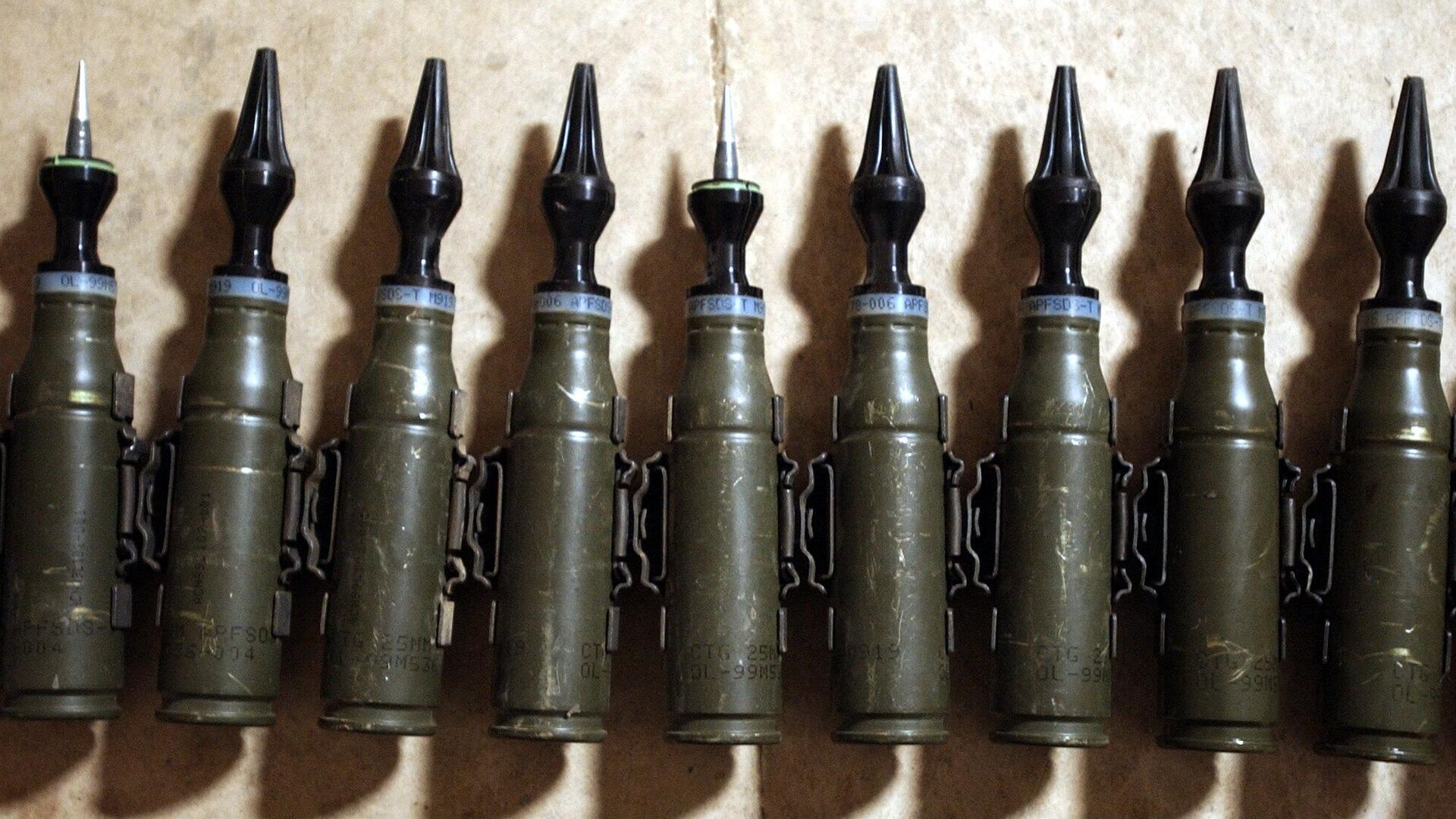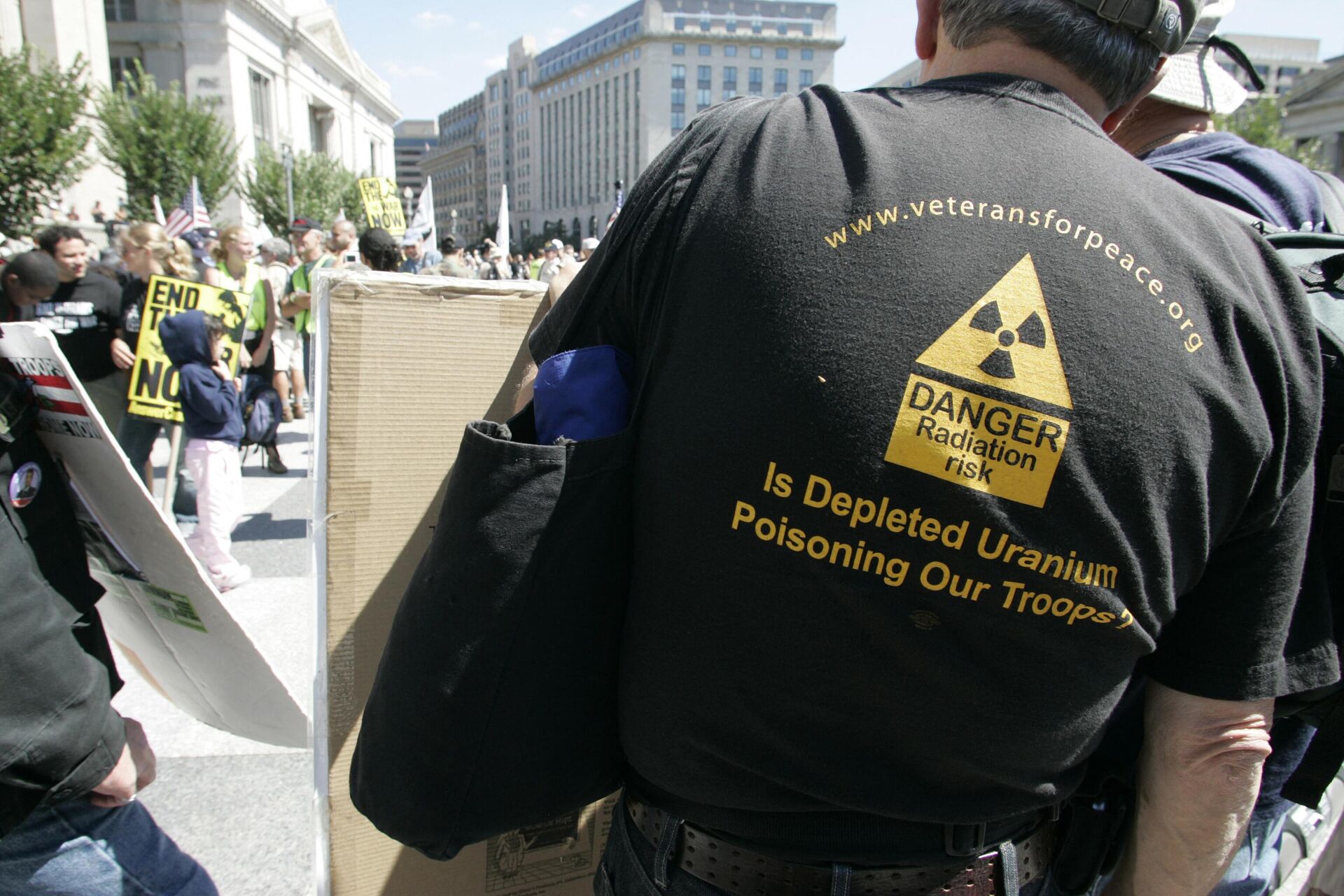What Are Depleted Uranium Shells and How Hazardous Are They?

© AFP 2023 / STAN HONDA
Subscribe
The British government pledged earlier this week that it would give Ukraine radioactive depleted uranium ammunition for the British main battle tanks Challenger 2 that London promised the Kiev regime.
Russia’s President Vladimir Putin has warned that Moscow would react “accordingly” to the transfer of depleted uranium tank shells to Ukraine, where Moscow continues its special military operation.
Russian Foreign Ministry spokeswoman Maria Zakharova, for her part, told Sputnik that the UK’s plan to deliver depleted uranium projectiles to Ukraine is London’s latest reckless provocation, aimed at bringing the situation in Ukraine to “a new round of conflict.”
So what are depleted uranium shells and do they pose a threat to human health and the environment? Sputnik explains.
What is Depleted Uranium?
To better understand what depleted uranium (DU) is, it’s necessary to recall that uranium ore contains a mix of isotopes, namely, forms of the element with slightly different physical properties.
This ore is processed to increase the content of the most radioactive isotope, U-235, which is used as nuclear fuel and to make nuclear warheads. The by-product of this uranium enrichment is known as DU, which is still radioactive, but at a much lower level than the starting material.
What is DU Used for?
The main applications of DU pertain to its high density. DU has been used as a counterbalance weight in aircraft, missiles, and even forklift trucks and boat keels.
Additionally, DU is in place in armor-plate for tanks and in armor-piercing shells that cause significant damage upon penetration. It is the very kind of projectile that the UK pledged to deliver to Ukraine, along with the British main battle tanks Challenger 2.
How Do DU Shells Work?
Apart from the explosive substance, a DU projectile typically consists of a plastic cap, an aluminum sabot, a DU penetrator and a thread for fins.
When the DU shell, for example, penetrates a target vehicle, the larger fragments tend to chew up whatever is inside, while the pyrophoricity of the uranium increases the likelihood that the vehicle's fuel and/or ammunition will explode.
The technical term used to describe the process is called "behind-the-target effectiveness."
Is it Safe to Say DU Poses Radiation Hazard?
Yes, because all uranium isotopes are radioactive. As it has already been mentioned, DU is much less radioactive, typically about 40% less than unprocessed uranium.
DU’s radioactivity is mainly related to alpha particles, which do not penetrate the skin. This means that a radiation hazard from DU mainly stems from breathing it in dust, eating or drinking contaminated food or water, or from shrapnel piercing through human skin.

An anti-war protestor wears a T-shirt questioning the use of depleted uranium in US weapons during a protest march from the White House to the US Capitol to demand an end to the war in Iraq, the return of US troops and the impeachment of US President George W. Bush in Washington 15 September 2007
© AFP 2023 / NICHOLAS KAMM
While NATO claims that no human cancer of any type has been seen as a result of exposure to DU, British Army doctors previously warned the UK Ministry of Defence that exposure to DU increased the risk of developing lung, lymph and brain cancer, and recommended a series of safety precautions.
The Agency for Toxic Substances and Disease Registry in turn warns that to be exposed to radiation from DU, “you have to eat, drink, or breathe it, or get it on your skin”, something that will most likely affect the normal functioning of the kidney, brain, liver, heart, and numerous other systems of a human organism.
Russian military expert Alexey Leonkov told Sputnik in this regard that although this kind of munition does not belong to nuclear weapons, fallout from the use of DU shells is partly tantamount to that of nuclear arms. According to him, the explosion of DU projectiles causes ionizing radiation that remains in such an amount that is dangerous to human health.
“The remnants of the use of this ammunition infect the terrain and armored vehicles. Due to the fact that destroyed armored vehicles are not immediately removed from battlefields, radioactive substances penetrate both the soil and open water reservoirs. Without special measures to denuclearize soil and water, it is impossible to get rid of the consequences from the use of these munitions,” Leonkov pointed out.
He was echoed by Igor Nikulin, a military expert and former member of the United Nations Commission on Biological and Chemical Weapons, who explained in an interview with Sputnik that at the time of the explosion of a depleted uranium shell, its core turns into radioactive dust, which scatters across the surroundings, infects the water and enters human lungs.
“The half-life of such uranium is several billion years, which is why the fallout will be in place for many centuries,” Nikulin said.
Which Conflicts Saw DU Shells Used?
The NATO war machine has used DU munitions in many of its campaigns since the end of the Cold War, sowing up to 2,300 tons of DU across Iraq during the 1991 Gulf War and the 2003 invasion of the country, also using the weapons in Afghanistan and Syria on a smaller scale.
Separately in 1999, the US and its allies spent 78 days bombing the now-dissolved nation of Yugoslavia and contaminating the Balkans with at least 15 tons of DU munitions.
In the wake of these bombings, Serbia suffers from one of the highest cancer rates in Europe, with close to 60,000 oncology diagnoses there made each year, and cancer among children is as much as two-and-a-half times above the European average. In the decades since the 1999 events, Serbian medics have also recorded an alarming rise in infertility, autoimmune diseases, and mental disorders.
Leonkov told Sputnik that in this vein, the consequences of the use of this kind of munition affected both the civilian population and the military personnel who used depleted uranium during the above-mentioned conflicts.
“1.5 million such shells were used during the hostilities in Iraq, where tens of thousands of citizens suffered from ionizing radiation and there was a sharp outbreak of oncology and an exacerbation of chronic diseases that then led to casualties. As it turned out later, neither the civilian population of Iraq nor civilians in former Yugoslavia received any compensation from US and UK authorities,” the Russian expert noted.
Nikulin, in turn, struck the same tone, stressing that “the use of such weapons in contiguous territories is extremely undesirable and must be stopped by any means.”
“I emphasize the word ‘any’. These tanks and shells must be destroyed immediately upon crossing the Ukrainian border,” he added.
They spoke after Russian President Vladimir Putin warned on Tuesday that Moscow would be forced to respond in kind if the West starts using weapons with nuclear components.
The remarks followed the UK’s previous announcement that it would provide Ukrainian forces with depleted uranium tank ammunition along with Britain’s Challenger 2 battle tanks, as part of London’s military assistance to Kiev amid the Russian special military operation. Moscow has repeatedly warned that the US and its allies’ military assistance contributes to prolonging the Ukrainian conflict. The Kremlin also said that Washington’s ongoing push to continue arming Kiev turns the US into a party to the Ukrainian standoff.



